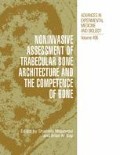Abstract
Bone strength depends on the volume of bone matrix, the bone microarchitecture, and also on the level of bone tissue mineralization. In addition to the amount of bone matrix, the degree of mineralization of bone tissue (DMB) can strongly influence bone strength and the bone mineral density (BMD) measured by dual energy X-ray absorptiometry (DXA). DMB is known to vary over microscopic regions with the age of the basic structure units (BSUs), the recently deposited ones being much less calcified than the older ones. During bone remodeling, after bone resorption, bone formation is a multi-step process. Following its deposition, the new matrix begins to mineralize after about 5 to 10 days from the time of deposition and the linear rate of thisprimary mineralizationcan be measured directly in vivo using double tetracycline labeling. After full completion of the BSUs (osteons in cortical bone or cancellous packets) asecondary mineralizationbegins. This process consists of a slow and gradual maturation of the mineral component, including an increase in the amount of crystals and/or an augmentation of crystal size toward their maximum dimensions. The secondary mineralization progressively augments the mineral content of bone matrix deposited during primary mineralization, the latter representing only about 50% of the maximum degree of mineralization obtained at the end of the secondary mineralization phase.
Access this chapter
Tax calculation will be finalised at checkout
Purchases are for personal use only
Preview
Unable to display preview. Download preview PDF.
References
G. Boivin, C.A. Baud, Microradiographic methods for calcified tissues. In:Methods of Calcified Tissue Preparationedited by G. R. Dickson, (Elsevier Science Publishers, Amsterdam, The Netherlands) 1984.
P.J. Meunier, G. Boivin, Bone mineral density reflects bone mass but also the degree of mineralization of bone: therapeutic implications.Bone21:373–377, 1997.
G. Boivin, P.M. Chavassieux, A.C. Santora, J. Yates, P.J. Meunier, P.J. Alendronate increases bone strength by increasing the mean degree of mineralization of bone tissue in osteoporotic women.Bone(in press, 2000).
P.M.Chavassieux, M.E. Arlot, C. Reda, L. Wei, J. Yates, P.J. Meunier, Histomorphometric assessment of the long-term effects of alendronate on bone quality and remodeling in patients with osteoporosis.J Clin Invest 100:1475–14801997.
Author information
Authors and Affiliations
Editor information
Editors and Affiliations
Rights and permissions
Copyright information
© 2001 Springer Science+Business Media New York
About this chapter
Cite this chapter
Boivin, G., Meunier, P.J. (2001). Changes in Bone Remodeling Rate Influence the Degree of Mineralization of Bone Which is a Determinant of Bone Strength: Therapeutic Implications. In: Majumdar, S., Bay, B.K. (eds) Noninvasive Assessment of Trabecular Bone Architecture and the Competence of Bone. Advances in Experimental Medicine and Biology, vol 496. Springer, Boston, MA. https://doi.org/10.1007/978-1-4615-0651-5_13
Download citation
DOI: https://doi.org/10.1007/978-1-4615-0651-5_13
Publisher Name: Springer, Boston, MA
Print ISBN: 978-1-4613-5177-1
Online ISBN: 978-1-4615-0651-5
eBook Packages: Springer Book Archive

